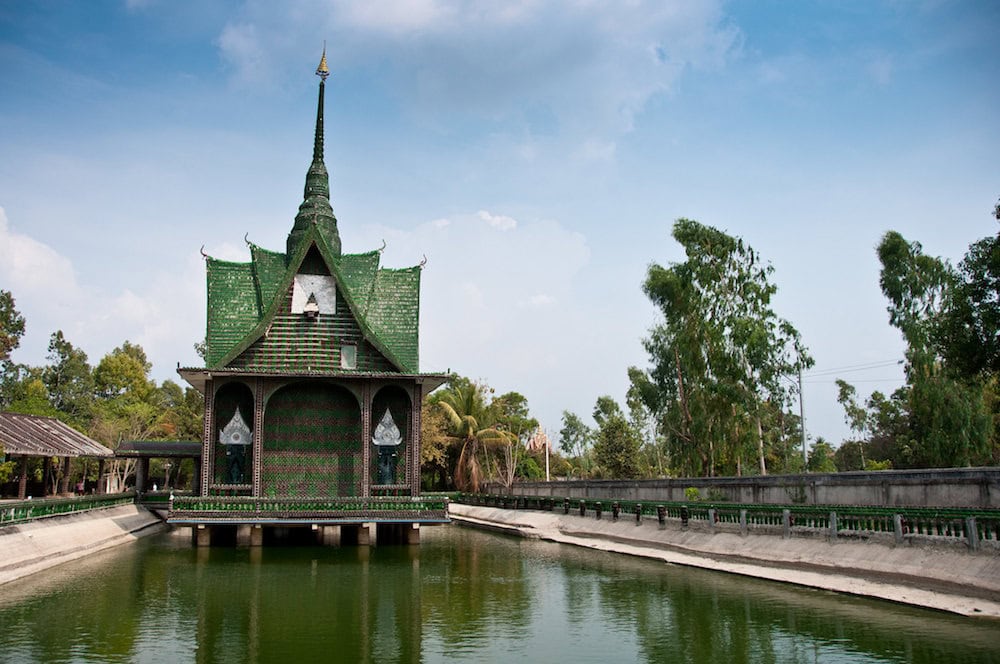
[Image above] The Wat Pa Maha Chedi Kaew temple in Thailand is made from more than 1.5 million empty beer bottles. Numerous other “bottle houses” around the world illustrate the feasibility of reusing glass bottles as building materials. Credit: Mark Fischer, Flickr (CC BY-SA 2.0)
In recent months, I’ve noticed a growing number of glass recycling initiatives taking place around the world, from Europe to South America. As the world increasingly acknowledges the environmental damage caused by single-use plastics, companies are exploring methods to achieve a circular economy—an economic system aimed at eliminating waste and promoting downstream use or recycling of resources.
Many glass recycling initiatives focus on crushing the original glass product and turning it into something else, such as a foam-glass substitute for gravel. However, you do not need to first crush glass to reuse it—glass bottles are good building material as is!
In today’s CTT, we take a quick trip around the world to view a few famous “bottle houses” that show the potential of reusing glass bottles in this way.
Thailand: Wat Pa Maha Chedi Kaew
Wat Pa Maha Chedi Kaew is a Buddhist temple known as the Temple of a Million Bottles because of its unusual construction—it is made from more than 1.5 million empty beer bottles.
The story of this temple starts in 1984, when Buddhist monks in the Sisaket province of northeastern Thailand decided to address mounting litter in the countryside. They encouraged residents to bring them recycled beer bottles, and in two years they had enough bottles to build the main temple. Since then, the monks have continued to collect bottles and have now constructed some 20 more buildings on the site as of 2009.
In the video below, you can see an overview of the site, which includes bungalows, a crematorium—and even a water tower!

Credit: It’s better in Thailand, YouTube
Azerbaijan: Bottle House of Ganja
The Bottle House is a local icon in Ganja, Azerbaijan. Unlike Wat Pa Maha Chedi Kaew, the Bottle House is a private residence with no hours or official guided tours.
The two-story house, which boasts around 48,000 bottles, was built by Ganja resident Ibrahim Jafarov in 1966–1967 in memory of his brother, who went missing during World War II. The house took Jafarov around 30 years to build, according to an Azerbaijan life video, which you can watch below.

Credit: About Azerbaijan, YouTube
United States: Grandma Prisbrey’s Bottle Village
Grandma Prisbrey’s Bottle Village, also known as Bottle Village, is a California State Historical Landmark located in Simi Valley, California. Tressa “Grandma” Prisbrey created the “village” of shrines, walkways, sculptures, and buildings out of materials from the local landfill during the 1950s–1970s.
Although the village was badly damaged in a 1994 earthquake, much of it is still intact and can be toured by appointment.
In the video below, which comes from a full-length film on the village, Prisbrey gives a tour of the buildings in the early 1980s.

Credit: Macondo Dev, YouTube
Mexico: Chapel of Jimmy Ray Gallery
The Chapel of Jimmy Ray Gallery is an art gallery in the Mexican state of Guanajuato. It was founded in 2012 as a way to present the work of Anado McLauchlin “along with select artists that Anado has bonded with on a visual and oftentimes emotional level,” according to the Chapel’s website.
The Chapel is located on 2.5-acre compound called Casa de las Ranas (House of the Frogs) where McLauchlin lives. The Chapel and Casa de las Ranas are both decorated extensively with mosaics and stained glass, but over 20,000 glass bottles are incorporated into walls and buildings as well.
In the video below, see how many bottles you can spot!

Credit: Dennis Keyes, YouTube
Update 02/05/2020 – Section added on Chapel of Jimmy Ray Gallery
Author
Lisa McDonald
CTT Categories
- Environment
- Glass


